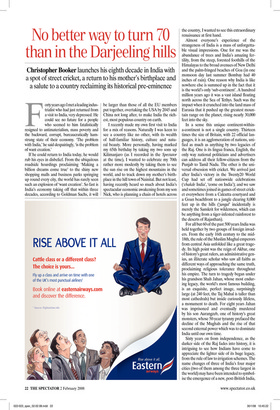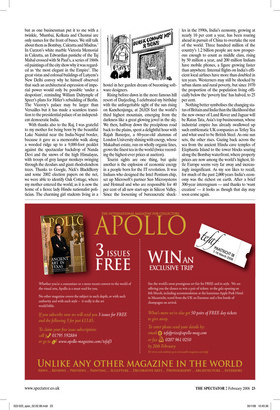No better way to turn 70 than in the Darjeeling hills
Christopher Booker launches his eighth decade in India with a spot of street cricket, a return to his mother’s birthplace and a salute to a country reclaiming its historical pre-eminence Forty years ago I met a leading industrialist who had just returned from a visit to India, very depressed. He could see no future for a people who seemed to him fatalistically resigned to antimaterialism, mass poverty and the backward, corrupt, bureaucratically hamstrung state of their economy. ‘The problem with India,’ he said despairingly, ‘is the problem of want creation.’ If he could return to India today, he would rub his eyes in disbelief. From the ubiquitous roadside hoardings proclaiming ‘Making a billion dreams come true’ to the shiny new shopping malls and business parks springing up round every city, the world has rarely seen such an explosion of ‘want creation’. So fast is India’s economy taking off that within three decades, according to Goldman Sachs, it will be larger than those of all the EU members put together, overtaking the USA by 2045 and China not long after, to make India the richest, most populous country on earth.
I recently made my own first visit to India for a mix of reasons. Naturally I was keen to see a country like no other, with its wealth of half-familiar history, culture and natural beauty. More personally, having marked my 65th birthday by taking my two sons up Kilimanjaro (as I recorded in the Spectator at the time), I wanted to celebrate my 70th rather more modestly by taking them to see the sun rise on the highest mountains in the world, and to track down my mother’s birthplace in the hill town of Nainital. But not least, having recently heard so much about India’s spectacular economic awakening from my son Nick, who is planning a chain of hotels across the country, I wanted to see this extraordinary renaissance at first hand.
Almost everyone’s experience of the strangeness of India is a mass of unforgettable visual impressions. One for me was the abundance of trees and India’s amazing fertility, from the steep, forested foothills of the Himalayas to the broad avenues of New Delhi and the palm-fringed beaches of Goa (in one monsoon day last summer Bombay had 40 inches of rain). One reason why India is like nowhere else is summed up in the fact that it is the world’s only ‘sub-continent’. A hundred million years ago it was a vast island floating north across the Sea of Tethys. Such was the impact when it crunched into the land mass of Eurasia that it pushed up the greatest mountain range on the planet, rising nearly 30,000 feet into the sky.
In a sense this unique continent-withina-continent is not a single country. Thirteen times the size of Britain, with 22 official languages, it is an agglomeration of nations, unified as much as anything by two legacies of the Raj. One is its lingua franca, English, the only way national politicians and advertisers can address all their fellow-citizens from the Punjab to Tamil Nadu. The other is the universal obsession with cricket. We arrived just after India’s victory in the Twenty20 World Cup had set off nationwide celebrations (‘chakde India’, ‘come on India’); and we saw and sometimes joined in games of street cricket everywhere from a Calcutta courtyard and a Goan beachfront to a jungle clearing 8,000 feet up in the hills (‘jangal’ incidentally is merely the Sanskrit for wilderness, which can be anything from a tiger-infested rainforest to the deserts of Rajasthan).
For all but 60 of the past 500 years India was held together by two groups of foreign invaders. From the early 16th century to the mid18th, the rule of the Muslim Mughal emperors from central Asia unfolded like a great tragedy. Its high point was the reign of Akbar, one of history’s great rulers, an administrative genius, an illiterate scholar who saw all faiths as different ways of approaching the same truth, proclaiming religious tolerance throughout his empire. The turn to tragedy began under his grandson Shah Jahan, whose most enduring legacy, the world’s most famous building, is an exquisite, perfect image, surprisingly large (at 240 feet, the Taj Mahal is taller than most cathedrals) but inside curiously lifeless, a monument to death. For eight years Jahan was imprisoned and eventually murdered by his son Aurangzeb, one of history’s great monsters, whose 50-year tyranny prefaced the decline of the Mughals and the rise of that second external power which was to dominate India until our own time.
Sixty years on from independence, as the darker side of the Raj fades into history, it is intriguing to see how Indians have come to appreciate the lighter side of its huge legacy, from the rule of law to irrigation schemes. The name changes of three of India’s four major cities (two of them among the three largest in the world) may have been intended to symbolise the emergence of a new, post-British India, but as one businessman put it to me with a twinkle, ‘Mumbai, Kolkata and Chennai are only names for the front of buses. We still talk about them as Bombay, Calcutta and Madras.’ In Curzon’s white marble Victoria Memorial in Calcutta, an Edwardian pastiche of the Taj Mahal crossed with St Paul’s, a series of 1860s oil paintings of the city show why it was regarded as ‘the most elegant in the Empire’. The great vistas and colossal buildings of Lutyens’s New Delhi convey why he himself observed that such an architectural expression of imperial power would only be possible ‘under a despotism’, reminding William Dalrymple of Speer’s plans for Hitler’s rebuilding of Berlin. The Viceroy’s palace may be larger than Versailles but it has made a seamless transition to the presidential palace of an independent democratic India.
With thanks also to the Raj, I was grateful to my mother for being born by the beautiful Lake Nainital near the India-Nepal border, because it gave us a memorable walk along a wooded ridge up to a 9,000-foot peaklet against the spectacular backdrop of Nanda Devi and the snows of the high Himalayas, with troops of grey langur monkeys swinging through the deodars and giant rhododendron trees. Thanks to Google, Nick’s BlackBerry and some 2002 election papers on the net, we were able to identify Oak Cottage, where my mother entered the world, as it is now the home of a fierce lady Hindu nationalist politician. The charming girl students living in a hostel in her garden dream of becoming software designers.
Rising before dawn in the more famous hill resort of Darjeeling, I celebrated my birthday with the unforgettable sight of the sun rising on Kanchenjunga, at 28,028 feet the world’s third highest mountain, emerging from the darkness like a great glowing jewel in the sky. We then, halfway down the precipitous road back to the plains, spent a delightful hour with Rajah Banerjee, a 60-year-old alumnus of London University shining with energy, whose Makaibari estate, run on wholly organic lines, grows the finest tea in the world (twice recording the highest-ever prices at auction).
Tourist sights are one thing, but quite another is the explosion of economic energy in a people born for the IT revolution. It was Indians who designed the Intel Pentium chip, set up Microsoft’s partner Sun Microsystems and Hotmail and who are responsible for 40 per cent of all new start-ups in Silicon Valley. Since the loosening of bureaucratic shack les in the 1990s, India’s economy, growing at nearly 10 per cent a year, has been roaring ahead in pursuit of China to overtake the rest of the world. Three hundred million of the country’s 1.2 billion people are now prosperous enough to count as middle class, rising by 50 million a year, and 200 million Indians have mobile phones, a figure growing faster than anywhere. Internal flights on India’s efficient local airlines have more than doubled in ten years. Westerners may still be shocked by urban slums and rural poverty, but since 1970 the proportion of the population living officially below the ‘poverty line’ has halved, to 25 per cent.
Nothing better symbolises the changing status of Britain and India than the likelihood that the new owner of Land Rover and Jaguar will be Ratan Tata, Asia’s top businessman, whose industrial empire has already swallowed up such emblematic UK companies as Tetley Tea and what used to be British Steel. As one sun sets, the other rises. Gazing back across the sea from the ancient Hindu cave temples of Elephanta Island to the tower blocks soaring along the Bombay waterfront, where property prices are now among the world’s highest, little Europe seems very far away and increasingly insignificant. As my son likes to recall, for much of the past 2,000 years India’s economy was the richest on earth. After a brief 300-year interregnum — and thanks to ‘want creation’ — it looks as though that day may soon come again.



































































 Previous page
Previous page